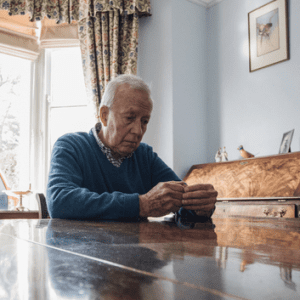Unaccompanied: Challenges And Triumphs For Those Aging Alone

Unaccompanied: Challenges And Triumphs For Those Aging Alone
November 19, 2025
Data has shown that there’s an ever-growing community of people aging on their own, without the support or companionship of a partner, adult child, or other loved ones. According to a recent AARP survey, 21% of US adults age 50 and above live alone, representing 24 million people, including one out of every 2 adults aged 75 and above. Even more concerning are the estimates by Harvard experts that by 2038, the majority of adults aged 80 and above will live alone. It’s not hard to guess some of the reasons for this, including longer lives, more “gray divorces,” fewer adult children, and more scattered family relationships. While many cherish the independence, freedom, and adventure that come with being on your own, for others, the challenges of navigating everyday life and activities, along with the planning and support most of us need in our later years, leave these solo agers in a vulnerable position.
Several recent stories in mainstream publications highlight the challenges for individuals and the communities in which they live when older adults are aging solo. For example, a recent Wall Street Journal article spotlighted a rural Virginia community whose community programs have been unable to keep up with the needs of solo seniors (and whose diminished staff is also aging). Government funding has failed to keep up with this growing problem that communities attempt to address with delivered meals, staff check-ins, transportation to medical appointments, etc. Moreover, these problems are likely to be compounded when Medicaid cuts of $1 trillion take effect next year, as Medicaid currently pays for some care in the home (while Medicare rarely compensates for help with daily activities). And while many of those aging and living alone prefer to stay in their own homes until the end (homes are now the place where the majority of people die), those who are aging alone often wind up in hospitals, where dying alone has become a serious concern, first coming to public attention during the height of the COVID pandemic.
Aging alone can also be much more costly than aging with a companion. Joseph Coughlin, Director of the MIT AgeLab, recently highlighted many of the hidden financial costs involved in aging alone. Paying 100% of all bills for food, utilities, housing, insurance, etc., means you can’t get the economies of scale you’d achieve when making purchases for 2 or more. Moreover, with no one to share the burden of upkeep and maintenance, you’re likely to have to hire more help, something many solo agers do not budget for during retirement. While tech support and gadgets can reduce some of this burden, those, too, are items that often require expensive purchases during your retirement years. In fact, with reference to the earlier-mentioned AARP survey, concern about money poses a major challenge for many solo agers. According to the Census Bureau, in 2021 figures, 63% of older adults in poverty were solo agers.
Another recent survey conducted by the Society of Actuaries (SOA) Research Institute has also highlighted the plight of today’s solo agers, but they have also published a series of resource guides intended to help solo agers navigate such issues as finances, health care, planning, legal concerns, technology, and support networks. The SOA survey underscored many concerns experienced by solo agers, including lack of companionship, insecurity about support networks, anxiety about changing physical and cognitive abilities, and the need to embrace and integrate technology into their everyday lives. To dig deeper into what the SOA survey revealed about the state of solo aging, click here and listen here.
The growing spotlight on the challenges facing solo agers has led to more attention paid to possible sources of help and support. For example, there is the Navigating Solo website, with links, videos, and programs intended to support solo seniors. There are also geriatric care managers or aging life care experts who can work with solo agers to put plans in place, and automate such tasks as bill paying or medical appointment scheduling in order to relieve some of the stress and burden of doing everything on your own. You can even set up a payment system on your own to handle bills you may forget or payments that need regular attention. Of course, many of these mechanisms and sources of support require financial means that you may not have the budget for. They also require planning in advance, something all experts on solo aging recommend. When you have no one immediately available to lean on, planning becomes yet another solo task you need to take on. But for your future self and well-being, this task becomes a good solo investment.







